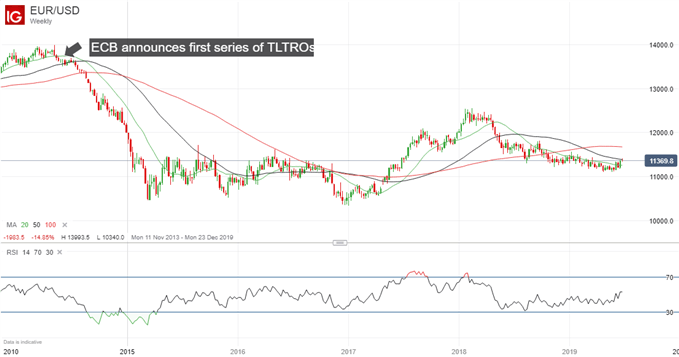Why financial market traders must monitor both monetary and fiscal policy:
-
- When trading financial markets, especially when there are concerns about a global economic slowdown, it’s essential to monitor both government fiscal policy and central bank monetary policy.
-
- When they are working together, the chances of a slowdown turning into a full-blown recession are substantially reduced.
-
- When they are not, an economic meltdown is far more likely.
Importance of monetary and fiscal policy when trading in an economic downturn
Trading the financial markets when economic conditions are poor, it is more important than ever to monitor both government fiscal policy and central bank monetary policy. It’s even more crucial when there are concerns that a slowdown could lead to a full-blown recession
That’s because the proper policy adjustments can avert a true crisis and prompt recovery, while the wrong strategy can potentially hasten and/or exacerbate the collapse.
What is the difference between monetary and fiscal policy?
Put simply, fiscal policy means a government’s tax and spending plans while monetary policy refers to a central bank’s decisions on interest rates and whether to push more money into the financial system or withdraw it. They are most effective when they are working together and least effective when they are pulling in opposite directions.
Note: our programmers have developed a profitable forex robot with low risk and stable profit!
Monetary and fiscal policy coordination
Eurozone Debt Crisis: How to Trade Future Disasters
In other countries, the wall between the government and the central bank is less solid. In Japan, the Ministry of Finance lost much of its authority over the Bank of Japan in 1997. However, it is still prone to political interference as was made clear when Japanese Prime Minister Shinzo Abe implemented a “three arrows” policy consisting of monetary policy, fiscal policy and economic growth strategies to boost private investment. The government, in turn, has been accused of being influenced strongly by big business, leading to the term “Japan Inc.”
Elsewhere, the central banks in countries such as India and Turkey are under strong pressure to bring their policies more into line with their governments’ fiscal policies. In China, perhaps surprisingly, the People’s Bank of China (PBOC) has some limited independence despite being ultimately controlled by the country’s Communist rulers. Some other Asian countries coordinate monetary and fiscal policy openly.
Hawkish vs Dovish: How Monetary Policy Affects FX Trading
In the US, President Donald Trump has repeatedly criticized the Federal Reserve and pressed it to cut interest rates – something it has so far refused to do, although reductions are on the cards before the end of 2019.
In a Twitter post in May 2019, Trump argued that “China will be pumping money into their system and probably reducing interest rates, as always, in order to make up for the business they are, and will be, losing. If the Federal Reserve ever did a ‘match’ it would be game over, we win!”
The response to his tweet was broadly negative but, as one commentator said at the time – and as explained above – this is exactly what Japan and China are doing, and Europe would too if it wasn’t worried about losing sovereignty at the country level. Another noted that “The Fed and the PBOC are more alike than you might think”.
Trading markets when central banks run out of options
From a trading perspective, it is the central banks that influence prices more directly. When they decide to raise or lower interest rates, hint that rate changes are on the way, inject money into an economy or drain it out, or devise ever more complex ways to influence the supply of money, prices react immediately.
Why Central Bank Monetary Policy May Fail to Avert Another Market Swoon
There is less response to government announcements of tax changes, austerity programs, infrastructure spending and the like – partly because their influence is longer term and partly because they can be offset by the central bankers if they decide, for example, that fiscal largesse is likely to boost inflation.

It is important to note, though, that when central banks run out of options, government policy becomes more important for markets. At the time of writing, official interest rates are negative in both Japan and Switzerland, and at zero in the Eurozone. Around the world, creative policies with ever more complex acronyms and various success rates have been introduced to bolster economies when rates can be reduced no further and conventional monetary policy seems to have reached its limit. Here are some of them:
-
- The Troubled Asset Relief Program (TARP) was introduced by the US in 2008 as a response to the subprime mortgage crisis and involved the buying of toxic assets and equity from financial institutions.
-
- The Term Asset-Backed Securities Loan Facility (TALF) was also created in 2008, by the Federal Reserve, to boost the economy – a good example of the government and the Fed pulling in the same direction. By contrast, some economists have argued that at present the government and the Fed are pulling in opposite direction, with fiscal policy loose at a time when interest rates remain high in comparison with many other major economies.
-
- Quantitative Easing (QE) has now become commonplace and describes central bank purchasing of government and other securities from the markets to boost the money supply and encourage spending.
-
- Quantitative and Qualitative Monetary Easing (QQE) with Yield Curve Control is a variant introduced by the Bank of Japan in 2016 when QE proved insufficient to boost inflation.
-
- Targeted Longer-Term Refinancing Operations (TLTROs) were designed by the European Central Bank to offer long-term funding at attractive conditions to banks in order to ease private-sector credit conditions and stimulate bank lending to the real economy.
The importance of such measures can be seen in the following chart, which shows how the announcement of the first series of TLTROs by the ECB in June 2014 led to a prolonged slide in EURUSD.
EURUSD Price Chart, Weekly Timeframe (November 11, 2013 – June 27, 2019)

Chart by IG (You can click on it for a larger image)
How Central Banks Impact the Forex Market
The lesson for traders is therefore clear: central banks and governments both influence markets. Policy announcements therefore need to be monitored closely – and never more so than when there are fears of a downturn turning into a global recession.
Resources to help you trade the forex markets:
Whether you are a new or an experienced trader, at DailyFX we have many resources to help you:
— Written by Martin Essex, Analyst and Editor
Feel free to contact me via the comments section below, via email at martin.essex@ig.com or on Twitter @MartinSEssex

 Signal2forex.com - Best Forex robots and signals
Signal2forex.com - Best Forex robots and signals




